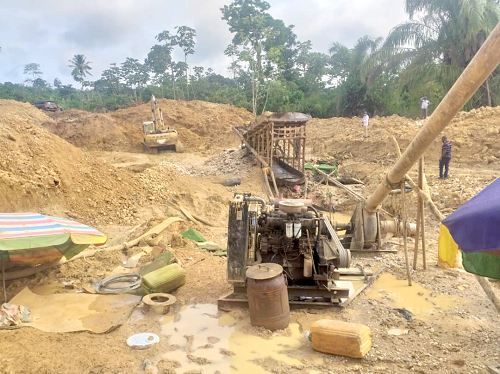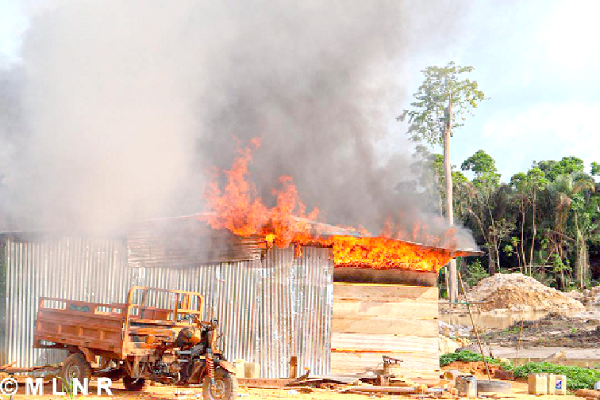Ghana News | Ghana Politics | Breaking News in Ghana

Fighting galamsey: Verdict, picking up the pieces
Galamsey has become a national crisis as the activities of those engaged in it have led to the massive devastation of land and water resources.
Foreigners, particularly the Chinese, had flouted the Minerals and Mining Act, 2006 (Act 703) that debarred them from participating in the country’s small-scale mining sector and were wreaking havoc on the environment with impunity.
Advertisement
With their local collaborators, including chiefs and political figures, they deployed excavators, chafan machines, and other equipment to forest reserves to strip them bare.
The galamsey operators have also polluted water bodies, such as, the Pra, Offin, Bia, Ankobra through the use of poisonous chemicals, such as, cyanide and mercury.
Apart from the devastation caused the environment, the galamsey activities has claimed lives, as hundreds of young men were trapped to death in illegal mining pits in the search for minerals.

Sections of the 100-hectares of land destroyed by galamsey operators at Tugakrom, a farming community near Dadieso in the Suaman District in the Western-North Region
Action
The President backed his words with action to clampdown on the menace and in April, 2017, imposed a six-month ban on all forms of small-scale mining.
That was followed by the setting up of a 10-member Inter-ministerial Committee on Illegal Mining (IMCIM) to help clampdown on the activities of the galamseyers; regularise the small-scale mining (SSM) sector and also reform the sector for sustainable mining.
The stakeholder ministries were the ministries of Environment, Science, Technology and Innovation, Lands and Natural Resources, Defence, Interior, Sanitation and Water Resources; Local Government and Rural Development and Chieftaincy and Traditional Affairs.
A joint police-military taskforce dubbed, Operation Vanguard, was also deployed on August 1, 2017, to go into mining communities and clampdown on illegal activities.
Additionally, a multi-sectoral mining integrated policy (MMIP) was formulated by the IMCIM with a comprehensive roadmap towards the lifting of the ban.
As part of the roadmap, the IMCIM set up a sub-committee to vet all small-scale mining companies to ensure that they had valid registration documents, tax identification numbers (TINs), and the approve documentation on their concessions.
After scrutinising the details of some 1,350 small-scale mining companies, the IMCIM validated documents of about 900 of those companies, following which the ban was lifted on December 14, 2018.

The Bia River that served as a source of water for the residents of Suaman District and other parts of the Western North Region, heavily polluted by galamseyers.
Reforms
As part of the new reforms to sanitise the mining sector, the Chairman of the IMCIM and former Minister of Environment, Science, Technology and Innovation (MESTI), Professor Kwabena Frimpong-Boateng, said there was collaboration between the IMCIM and the Drivers and Vehicle Licensing Authority (DVLA) to electronically tag all machines before the companies were allowed to use them at their concessions.
“Mining equipment, such as, excavators, bulldozers that have not been licensed and tagged with electronic devices by the DVLA will not be permitted for small-scale mining,” he said.
Additionally, he warned that the new reforms placed a ban on the fabrication, transportation and use of dredging equipment for use in water bodies, adding that offenders would be ruthlessly dealt with according to the law.
To deter illegal miners from the practice, the government amended the Minerals and Mining Act to give stiffer sanctions to offenders.
Under the reviewed law, offenders could be convicted to a fine not lower than 10,000 and not exceeding 15,000 penalty units or a prison sentence of not less than 15 years and not more than 25 years or both.

July, 2020, when the Minister of Lands and Natural Resources, Mr Kwaku Asomah-Cheremeh, led Operation Vanguard team to clamp down on illegal mining.
New Minister
Recently when the new Minister of Lands and Natural Resources, Mr Samuel Abu Jinapor, paid a courtesy call on the Asantehene, Otumfuo Osei Tutu II, in Kumasi, the Asantehene charged him to take bold steps to stem the menace of illegal mining popularly known as galamsey.
He said the nation could not wait any longer in ensuring a complete elimination of the canker as that was the surest way to protect the nation’s natural resources and water bodies.
Conflicting verdict
Almost three years into the galamsey fight, specifically on September 12, 2019, the former Minister of Lands and Natural Resources, Mr Kwaku Asomah-Cheremeh, while giving updates on activities in the mining sector to the press, said the government had won the galamsey fight, on a ranking of one to 100, by 85 per cent.
"The government desires that we get to a 100 per cent success rate, but there are a few miscreants who are making it difficult for all of us," he had indicated.
However, that claim was put to the test when evidence of widespread galamsey activities sprang up across mining areas.
On Saturday, November 30, 2019, the Municipal Chief Executive (MCE) for the Kwahu West Municipal Assembly in the Eastern Region, Mr Yaw Owusu Addo, made a distress call to the government to help save the area from the hands of illegal miners.
Again, on January 16, 2020, a fact-finding visit to the Oda River Forest Reserve located in the Amansie Central District of the Ashanti Region by Mr Asomah-Cheremeh and a military deployment found that the forest reserve was under siege by illegal miners.
Another swoop on illegal mining sites at Tugakrom, a farming community near Dadieso in the Suaman District in the Western-North Region onTuesday, June 9, 2020, showed that over 100 hectares of the forest cover had been wiped off by illegal miners.
Wild chase?
These, and many other reported cases of galamsey, have gotten tongues wagging and describing the galamsey fight as a wild goose chase.
A Deputy National Director of A Rocha, Ghana, a non-governmental organisations (NGO) in the environment sector, Mr Daryl Bosu, said although the fight against galamsey started on a very good note between 2017 and 2018, "continuous impunity and interference by political actors from the executive and associated agencies, especially from 2019 onwards, eroded the gains.
He added that the latest call by the President for an engagement on galamsey, was an admission that the campaign had been lost because of politicisation of the process.
Mr Bosu said the question about having an engagement on how to deal with galamsey was a non-starter because "we already know the impact of galamsey on our lives and that is why we gave the government full support to fight it".
The Convener of the Media Coalition against Galamsey, Dr Kenneth Ashigbey, shared in the view of A Rocha Ghana, and added that although the call for a non-partisan discussion on galamsey was a step in the right direction, outstanding issues in the four-year fight must be resolved first.
Nutshell
Currently, about 2.4 million hectares of the country’s land surface that has been degraded through illegal mining is yet to be reclaimed.
Prof. Frimpong-Boateng had estimated that it would cost about $29 billion to reclaim the degraded land, because every hectare would cost $12,000 to reclaim.
The forest cover of the country had also reduced from 8.8 million hectares before independence to a low of about 1.9 million.
Many cocoa farms are still being destroyed by illegal miners just the same way as water bodies continue to be polluted.
If the fight against the menace is to be won, the government needs to heed the call by many stakeholders for the depoliticisation of the approaches and interventions.
The mandated state institutions, especially the Minerals Commission, needs to be retooled and empowered to enforce the mining laws and protect the environment.
Writer’s E-mail: [email protected]




